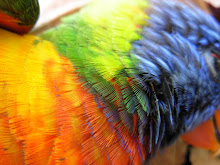Bronze Wing
Bronze Wing 5th October 2008
Once again I found myself following that ribbon of gravel, following the stream to Hovea Falls.
Each time I arrive I am reminded to live in the moment.
I find myself thinking, it is not the destination but the journey that matters... and so I am walking, listening and watching.
Today the floral arrangements that surround me are vivid.
Vivid blues and reds, and occasional orchids line the path.
And that distant bird sound, that one with its ethereal high-pitched melodic whistle seems to follow me, singing in harmony with the nearby gurgling bubbling brook that borders the walking trail. And I am walking...
Today in the company of a friend I was walking full of child-like anticipation for what flower or oddity of granite formation we might find.
And later, finding ourselves at the John Forest National Park Tavern, drinking tea from a sparkling silver teapot, we sat talking sipping tea in the company of a dozen grey doyens of the bush with their pouches full and twitching, and we saw them...for there, stepping between the half-shadows of grey feeding kangaroo were the fearless bronze wings.
In Noongar the bronze wing pigeon is called the Moritch but, unable to glimpse the deeper meanings of their naming, it is the English adjective in describing their wing that resonates most deeply.
But this bird, ever-determined moving in and out in the shadows of paw and claw-footed kangaroo exudes a wing that shines metallic green as well as bronze.
Its wing's colouration resembles the blue-wing inner-linings of the black duck, which in turn finds a connection with the dark green of the European mallard.
But this colouration, this distinct patch shining glistening on the upper forward tract of its wing seems to speak of some function or other, but attractive and attracting to whom?
It is spring and perhaps the vividness of its colouration speaks of its biological intent and endeavor, its intentions to find a mate, or to signal it has found one. Perhaps what I am seeing reflects the success of the species, an adaptation formed from a life spent deep in the forest, an adaptation formed amid the forest green, something born and worn of signification and magnification, magnified in the eyes of their species, but half-hidden in the grass, camouflaged from the eyes of the predator.
And yet to imagine the formation of such a markings is to imagine and to see it in other life-forms as well.
All of us are marked or camouflaged at some time in our lives.
For the Hindu, both woman or man, for example, adorned with their third eye, their sari or bangles, or for western woman, for some, with their nose rings, tattoos and bright colours speaks in signs, and signals the evocative vocabulary of unsaid words and narratives and stories that never end.
Sometimes I find myself mingling with the throng.
Sometimes, half-stepping the fruit carriers at the markets, my head is spun from the scent of patchouli.
It is really a hippie's errand - a message to the world, that to both the wearer and receiver, it speaks in a tongue meant to allure, to transform.
For some who wear it, their scent is forgotten and only remembered when others make comment, who know its attraction.
And it seems to me, that just like the bronze wing, that we too share something in common attempting to allure and to speak without speaking, either in scent or in colour.


2 Comments:
you are so right, not only to allure tho but also to reinforce what we truly believe or desire ourselves to be. And Bronzewings must be the ditziest birds in the universe this time of year. Aren't they funny? Their minds are really on the job - not insignificant things like avoiding traffic or cats and dogs! Have you ever heard their wings slap together with quite a 'crack' in the afternoon as they fly? How and why do they do that?
Yes Sarah I agree. Is it what we believe or what we desire? Or are they the same thing? For each seems the substance of imagination, imagining what we might mean to another. Or is desire another quality entirely? More yearning than believing... And I am getting the sound of the bronzewing in flight confused with the topknot or crested pigeon... or do they both clap their wings in flight?? Maybe it's a survival technique, rapid in flight alerting the others olf its specie to the watchful eye of the preditor? Many thanks for your comments.
Post a Comment
Subscribe to Post Comments [Atom]
<< Home